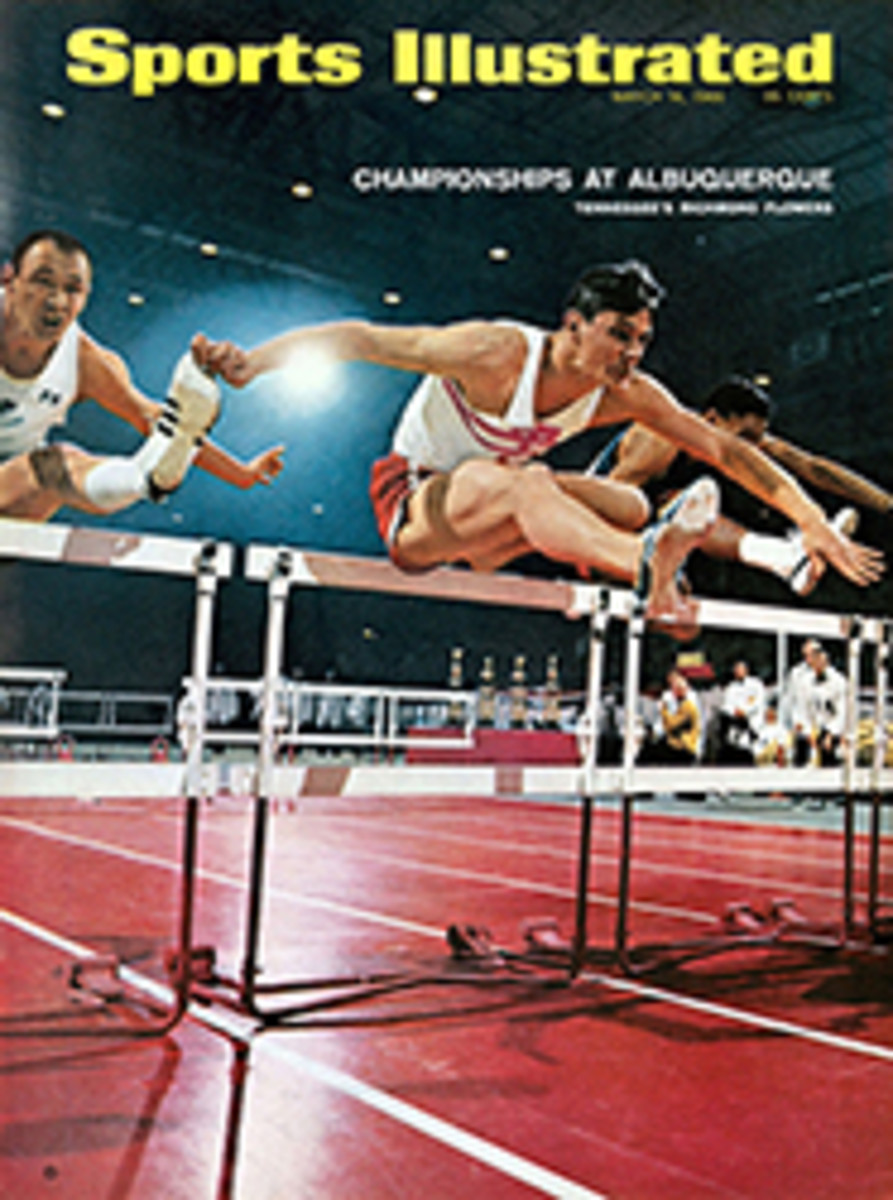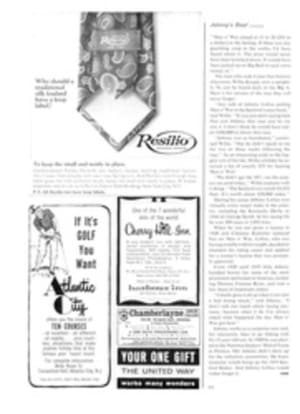
VERO: BASEBALL BY THE NUMBERS
It is fact-facing time at Vero Beach. Short days ago it was a bright new spring on the Los Angeles Dodgers' proving grounds behind the old Navy barracks, and all things seemed possible. For a precious little while the undersized sandlotter in the oversized shirt could be one with Pete Reiser, who came down the road so many, many bright springs ago, carrying glove and spikes like a bum's bindle, and sold a million-dollar ballplayer for a hundred bucks. For a day or two each pitch loomed big and juicy as the grapefruit on the trees out front, and the $9 shoes were seven-league boots. Then, gradually, the crisp crack of the bat became a clunk. Line drives up the alley became ground balls to the second baseman as little flaws made the little differences that make the big difference. Elderly coaches touched young shoulders and said quiet words. In 10 days the new spring had grown old.
MEASURING UP FOR A GAME OF INCHES
They were going to make Edwin D. Snider a great hitter if it killed him, and it was killing him. For more than an hour he had stood in the batting cage, flexing his 21-year-old muscles, and just watched as pitch after pitch, from pitcher after pitcher, went by. "Strike," he would growl, grinding the bat into his left shoulder. "Ball," corrected George Sisler, in the chair of hitting behind the cage. This was the spring of 1948 and the Vero Beach faculty had decided that future box scores out of Ebbets Field would say "Snider, cf." But not now. He had a natural swing, to be sure, but he needed an unnatural acquaintance with the strike zone. So he was sent to Professor Sisler's remedial-reading class. "Ball?" "No, strike."
On another of the several diamonds behind the gloomy old barracks, Professor Branch Rickey was interviewing a student pitcher, asking silly questions. "This how you grip the ball for your curve? Are you married? Why aren't you?" What the hell did he care? He didn't. As he talked, Rickey was manipulating the fingers on the ball. Searching his mind for an attitude toward matrimony, the recruit was changing his grip for the curve.
When a coach with a clipboard blew a whistle, the young pitcher and the rest of Unit B would move to Diamond 3 for a lecture on the balk rule. At length Snider would stomp angrily off to rejoin Unit A in the sliding pit—or was it Unit D for the 60-yard dash?
The strong, eager, awkward young men were bored by the nit-picking curriculum of Vero Beach. When Duke Snider's hair had turned to silver and the Mobil station behind Bedford Avenue had been declared a disaster area, it still bored him. If the by-the-numbers procedure became less mechanistic after Rickey's departure, it became more exacting. In that première season of 1948 Vero Beach accommodated 550 players and impostors; this year, with the minor leagues diminished unto the point of Walter O'Malley's tears, the whistles blew for only 200. Thus the teacher-pupil ratio is the better to see you with, my child.
And the 200 grumbled. If you didn't know the fundamentals, you wouldn't be in a big-league camp, right? So what's this this-is-a-baseball jazz? This place is like a concentration camp, anyway.
The prototypal attitude toward Vero Beach was established by the attitudinous Mr. Leo Durocher. In that spring of 1948 the flowers reappeared on the earth and the voice of The Lip was heard in Indian River County saying, "The hell with this." Back as Dodger manager, after the year's exile Happy Chandler had imposed upon him for being Leo Durocher, he found things changed. The Dodgers had taken over this slightly used naval base at Vero Beach, which in those days was the kind of place they put military bases, and all hands would be billeted in drafty, drab-green wooden barracks.
Moreover, Mr. Rickey had decreed, all hands, from Class D outfielders to the dandy little manager, would carry trays on the chow line. With clear blue eye, Durocher perceived a New Frontier of Togetherness. Within minutes, Leo and his bride were resident in a civilized motel on the beach. A practitioner of victory with finished players, he was never much interested in their beginnings. He would see them later.
The fundamentalist method of Vero is dull, even to watch. But it may be a clue to understanding the implausible success of the patchwork Dodgers of 1959 and the short-ball specialists of 1963 and 1965, teams that "made errors but not mistakes." To say those great battles of the National League were won on the playing fields of Vero would be oversimplifying, but by how much? If baseball is truly a game of inches, they first put the calipers on it at Vero Beach in the spring of 1948, after Rickey decided the game was not as inexact a science as those who practiced it badly believed.
With the Socratic approach he used so well when it suited his purpose, Rickey proposed to inquire if baseball were not a game of axioms, largely untested. Probably some contemporary of Cap Anson theorized that right-angle turns were a quicker way around the bases than the great circle route, or that the hook slide was, literally, a waste of time. But nobody before Rickey approached those matters with stopwatch and tape measure, meticulously charting and analyzing the findings.
Neither had anyone organized a baseball organization to the IBM extreme, as it was under one big, happy tent at Vero. If the system worked, Pee Wee Reese and the shortstop of the Ponca City, Okla. farm team would approach a low-hit ground ball in the same way—the Dodger way.
The system did work. Mr. Rickey projected five pennants in the next 10 years, and that's what happened. One must "have the horses," an unquestioned axiom says. Does one? If the 1953 Dodgers was a juggernaut, the 1965 vehicle was a flivver, and it got there just the same. It has been 10 years since a Dodger team scared anybody, but they still make everybody nervous.
Last May Day, when everybody was saying there was no way the Dodgers could win, Manager Walter Alston was explaining the one way they could. They would, he said, "have to do every damned little thing you can think of."
And, it was implicit, a lot of damned little things you don't even think of, because they were the boring little things they taught at that concentration camp at Vero Beach.
TEN PHOTOS
JAMES DRAKE
They say The Strings are the same size as the strike zone, but they aren't happy if you don't hit the bottom strand. ("A guy said Sandy Koufax couldn't find The Strings—some old catcher used to warm him up with shin guards on") Always keep a bat handy, because it might be your turn to hit, and it might be your only chance. Oh, stoopball. I thought those things were handball courts.
Well, Iron Mike don't really throw a changeup, but he sure gives you a lot of motion. And he's wild. That's embarrassing, to get knocked down by a pitching machine. I hope the old man wasn't watching. Is he here to watch me? Naw, I guess he just wanted someplace to sit down. Meet the ball. Just meet the ball. Boy, I coulda hit that one downtown. Wait on the pitch. Hit down on the ball. They like that. Whaddesay? Me? Yeah, me. He is watching me. Shorten the stride, yes sir. How can I go to right field when the damned thing jammed me?
What is this, the Olympics? Run, run. Who said you had to run to be a catcher, for Cod's sake? Ptoo. A hundred years people been working up strawberries learning the hook slide, and these guys want you to belly whop. "You get there quicker." Yeah, you get more dirt in your teeth, too. Run, run. I can't see, but first base ought to be about here. Or pretty soon, anyway.
Today they post The List of the squad that's going to play in Miami. Don't run to look at it; that would be bush. If you ain't on it, they could be keeping you here for a longer look. Yeah—it could be all she wrote, too.

